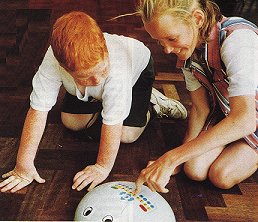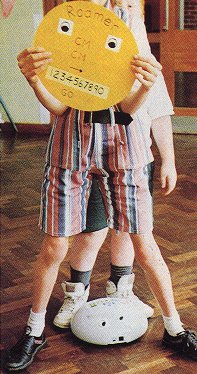
|
Feedback Form

A WANDERING STAR 1?

Maggie Wagstaff is an Advisory Teacher for IT and SEN and, as she says, has "the good fortune to be working in all the MLD (mild learning difficulties) and SLD (severe learning difficulties) schools in Warwickshire."
Roamer was introduced into our MLD schools just two years ago.
Rewards came immediately; as the mere presence of a mystery box in the classroom gave rise to prediction, pretending and a feeling that what was inside would please the children.
One child quite accurately guessed the box's contents. "It's something to do our work for us." Wishful thinking on their part, although I don't think they ever saw Roamer activities as work!

Roamer had been planned into the project work of three classes. A 5 to 7 year old class, 10 and 11 year olds and a 13 to 14 year old group. The younger children were enjoying a Journeys topic, the middle group were studying Shape and the older children were involved in all things Roman; they were particularly captivated by the Roman Army.
One pre condition of using Roamer was that there should be evidence of cross-curricular planning to include suitable activities for Roamer. Another was that the children should have done some preparatory work on direction and instruction giving. (I hasten to say that these criteria were not devised by me, but by the headteacher and were an answer to one Roamer at the demand of 8 classes.)
It says much for Roamer's popularity that 8 plans were submitted. Faced with such demands the school decided to buy another one.
I was delighted to find that the ongoing work on directions and turning in PE lessons, drill marching exercises for Roman soldiers and a playground and classroom floor covered in shape markings, all gave the children a distinct advantage when they were introduced to programming Roamer.
For the youngest children, a stepping stone game was devised. This involved a set of circles cut to match Roamer's shape. These were placed on the floor, first in a straight line, later with turns to right and left. Two different kinds of sweets or fruit were placed in opposite positions. A child was then given a stone to stand on, a reward was chosen (with time penalties for the tardy!) Instructions were then refined to hasten the child to the selected reward.

It was surprising how quickly we lost the vague and imprecise language and homed in on directional commands and realistic distances to step. For these children the language work integral to this project was crucial. There were also some innovative problem solving strategies from children from whom we had seen little evidence of forward, let alone lateral, thinking. It became quite a challenge to see how many different ways could be found to get to one place.
We even found several children who could not walk backwards, this offered some further opportunities for a PE development.
If this all seems a very roundabout way of beginning work with Roamer, I can only say that for these particular children it paid dividends.
Roamer trundled into their classroom just as they were embarking on road building with their construction apparatus. A tea break was called and the children gathered around offering their suggestions for making Roamer "go".
It was obvious that the keypad was to be used. Green for go was tried, but they wanted it to go from one designated place to another. At this point they were reminded of their stepping stone game and the correct sequence of instructions soon followed. The pressing of CM twice was well explained by their teacher.
"Is it any use me telling you things once?" she asked the class. "No," they replied, "You always have to say it again!".
The idea of clearing memory was reinforced when the children played at being robots in their preparatory work, they had had a "clear mind" button. They were also familiar with the "clear" button on the talking calculator which was used in their counting work.
Once Roamer had made his entrance he was in great demand. Stacks of bricks were assembled to test his demolition skills. Self correction was the biggest bonus here, the cheers on demolition were not quite so welcome! If Roamer failed to hit target then it was easy, you simply adapted the number of steps.
A tunnel was made with a chair and a piece of cloth. Roamer went in one side and out the other, to more cheers! Then he went in one side and came out the same side ... backwards. There was some interesting maths work involved in ensuring that he came back to the exact place he started from. When I left the classroom one child was still not convinced that if we walked forward six steps and backwards six steps, we would end up in our starting place and the problem was not one of uneven stepping!
The tunnel enthusiasts were eager to explore the "sing" key. They knew he could make a noise because they had heard it in the demonstration program, they reckoned the "sing" key was the clue, but could not come up with the instructions to activate it.
"Sing, number, number," became their incantation for playing a tune. The finer points of pitch and duration were put on hold and they soon discovered a "Roamer doesn't understand" noise if the first number chosen was larger than 8.
They wanted to know what all the keys did and they became familiar with W for wait. But we noticed that they did not make use of the Clear Entry facility, preferring to start over again if they heard Roamer complain.
Turning was accomplished in the first instance by physically lifting Roamer up and repositioning him. But eventually, with his units of turn changed, the majority of the children achieved this by programming. We were pleased to discover that a few of the children wrote their programmes down, because they said they kept forgetting where they were. We made cards with arrows and numbers for them to lay on the floor. Now of course they could use the Roamer playing cards for this purpose.
Work with Roamer continued to complement the Journeys topic and Roamer was even sent off with the register one morning. He needed a trailer, which gave rise to design and build work, not to mention a towing hook, which was finally resolved with a stick on suction hook from someone's bathroom.
This class were often seen wearing strange hand and foot stickers indicating left and right. They were also sighted waddling up and down corridors wearing Roamer feet. These were circles of card exactly the same size as Roamer and designed to enhance their estimation skills.
Roamer was fun. He was a companion, many of the children talked to him constantly. He was a motivator for action; children with learning difficulties are often not keen to take the initiative themselves and will often be passive watchers instead of instigators of exploratory activities.
As for our aspirations for learning outcomes, well, we had more work than the school day could accommodate and a tool that the children could and would think with. I have chosen to concentrate on work developed with the youngest children because we hope that as Roamer is used throughout the school, we should be able to plan for progression. Maybe we can satisfy the National Curriculum requirements for Measurement and Control and enrich the children's learning in far wider spheres.
Although our SLD schools were also keen to try using Roamer, at first they expressed concern about his fragility. However two years have passed and no injuries or fatalities have been reported!
| Back |
|---|